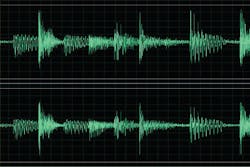Can you hear it now: Low frequency tones a new requirement for smoke, CO detectors
We all know the drill. When the fire alarm goes off, we know to evacuate the building as soon as possible. Fire and life safety detection technology has advanced to the point where we can be notified of a fire at the earliest point of inception, giving us enough time to take action.
But how familiar are you with the advancements made for the hearing impaired? Various non-audible devices, ranging from bed or pillow shakers to strobe lights, have been promoted as life safety products for these individuals.
In addition, new technologies are emerging that meet updated code requirements and address the need for audible notification appliances to be heard by people with a mild-to-severe hearing loss.
Low Frequency Tone
A study conducted by researchers from Victoria University in Australia released in May 2006 tested numerous auditory signals and alternative alarms. The goal of the study, which was sponsored by the Fire Protection Research Foundation, was to determine which were most successful at waking and alerting individuals with partial hearing loss during an emergency. The research found that a lower frequency tone was much more effective than the 3,100 Hz higher frequency tone commonly used in smoke alarms and audible notification appliances (horns).
Audible emergency evacuation signals set at a 520 Hz square wave tone awakened 92 percent of the hard-of-hearing test participants when used at or below the code-minimum sound level of 75 decibels for 30 seconds. A square wave is different from a pure tone signal in that a square wave consists of a specific fundamental frequency and an infinite number of subsequent peaks at odd-numbered harmonics.
The success rate was 100 percent for the 520 Hz square wave tone at 95 decibels. On the other hand, one study found that only 57 percent of hard-of-hearing individuals awoke to a 3,100 Hz signal up to 75 decibels.
Even though there are as many as 70 million Americans with high-frequency hearing loss, all can benefit from having alarms with low-frequency pitches. Statistics show that senior citizens are not as likely to awaken to a traditional smoke alarm. According to the Topical Fire Report Series of 2004, adults ages 64-plus represented 12 percent of the U.S. population, yet accounted for more than 30 percent of all fire deaths.
Most children, deep sleepers, alcohol-impaired individuals, and people taking sleeping medications are also less likely to wake up when a smoke or CO alarm sounds. The research also showed that the low-frequency signal was 63 to 69 percent more effective at waking children, heavy sleepers and people with hearing loss than current high-pitched alarms, demonstrating the effectiveness of the lower frequency 520 Hz square wave signal in arousing sleepers in all these instances.
Code Adaptation
With the passage of the National Fire Protection Association’s (NFPA) new code provision that requires a lower frequency signal, these individuals will have a higher chance of awaking when a fire occurs.
According to Chapter 18 of the 2010 and the subsequent 2013 editions of NFPA 72, notification appliances connected to a protected premises system are now required to emit a 520 Hz square wave tone. Specifically, the change requires that audible appliances which produce signals for sleeping areas must emit a low frequency signal of a square wave centered around 520 Hz by January 1, 2014.
According to Section 18.4.5.3, this is to be applied regardless of whether the notification appliances are required by governing laws, codes, or standards, or if the notification appliances are provided voluntarily for those persons with hearing loss. As a result, if notification appliances are required in sleeping and guest rooms, then they now need to meet the new requirements of NFPA 72: 2010 and 2013.
In the 2013 edition of NFPA 72, the verbiage was slightly changed to clarify that the low frequency requirements were intended only in the sleeping spaces.
NFPA 72: 2010 the Chapter 29 requirements for household applications, specifically for those with mild-to-severe hearing loss, call for audible notification appliances that produce a low frequency 520 Hz sound. For those with profound hearing loss, the requirements include tactile notification appliances (such as a bed shaker) in addition to high-intensity visible notification appliances. Sleeping areas for those with mild-to-severe hearing loss have to use an audible notification appliance that produces a sound wave with a low fundamental frequency of 520 Hz.
In response to the changes in NFPA 72 for low frequency smoke and fire alarms in sleeping rooms, NFPA 720, The Standard for the Installation of Carbon Monoxide (CO) Detection and Warning Equipment, likewise adopted new provisions for the hard-of-hearing and profoundly deaf communities. NFPA 720: 2012 has identical provisions to those in NFPA 72: 2010 for notification appliances connected to a protected premises system. The effective compliance date is January 1, 2015.
The 2015 edition of NFPA 720 is expected to have identical provisions to those in NFPA 72: 2013. These provisions in NFPA 720 are intended to provide the same protection from CO hazards for hard-of-hearing and deaf individuals as NFPA 72 provides to these same individuals from smoke and fire.
Adaptation of these codes vary throughout the U.S. Follow manufacturer instructions and your local building/code regulations for the use and installation of any audible visible notification devices.
To accommodate these code updates, fire and life safety manufacturers continue to develop innovative solutions. There are now sounders and sounder strobes that provide the required low-frequency square wave tone. Some of these new devices are dual listed for wall- or ceiling-mount installations and are compatible with systems with proprietary synchronization protocol.


